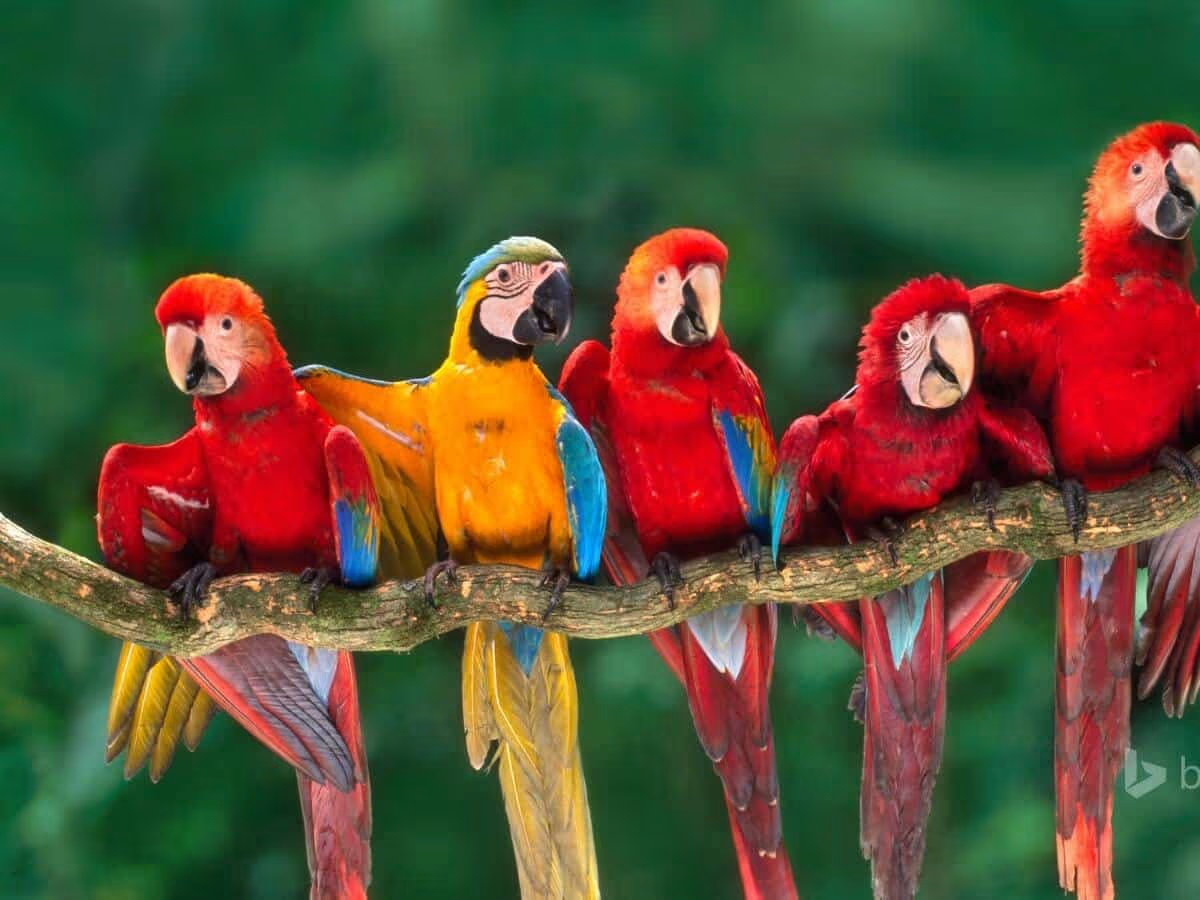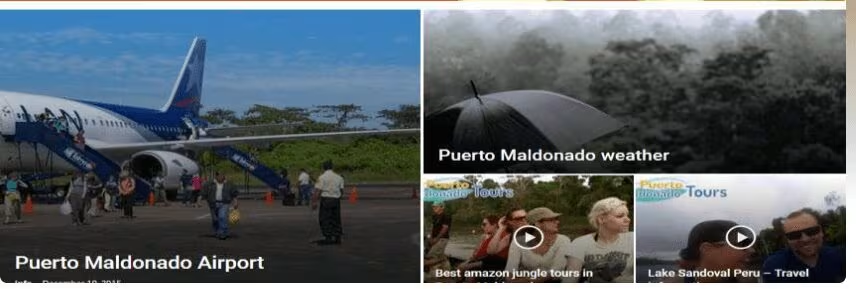Tour Activities:
Birdwatching, Canopy Walk, Cayman search, Jungle walk, Kayaking
Tour Attactions:
Macaw Clay Lick, Parrots Clay Lick, Tambopata River
Tour Includes:
This is an “All inclusive tour from pick up till drop off”
Pick up from (Airport, bus station or hotel)
03 Nights accommodation in bungalow with private bathroom
1 Ticket entrances to natural reserve 1 to (Macaw clay lick)
1 Professional bilingual guide in the jungle
1 Motor boat transportation for all trips
Breakfast (3) Dinner (3) Lunch (3)
All activities listed in the itinerary
Purified Water 24 hours (To recharge your canteen)
Wellingtons (Rubber boots)
No additional payment for single room or (Solo traveler)
Storage room for large luggage
First aid kit
Drop off to (Airport or bus station)
Where you’ll be:
Day 1
Arrive in Puerto Maldonado, the capital of Madre de Dios, and join a 1-hour bus and 2.5-hour boat ride to the lodge. Your first taste of Amazonian gastronomy will be in the river while you leave the city to enjoy the incredible jungle landscapes.
As we cross the confluence with the Malinowski River, we will leave behind the last traces of human habitation. Within the uninhabited core of 700,000 hectares of the reserve, sightings of capybaras, alligators, geese, macaws and other large species will be more frequent.
The Tambopata Research Center awaits you, a spacious boutique eco-lodge, with a bar, massage center and buffet service in the heart of the Tambopata National Reserve, being the only shelter within the reserve surrounded by dozens of nests of macaws belonging to to the Guacamayos Project.
The accommodation includes rooms from 21 meters to 83 meters suites with private bathroom and a window open to the forest.
Your stay includes three meals a day, tea, coffee, excursions and guided activities, refreshments upon arrival, and transfers to and from the airport. We assign guides in small private 6: 1 groups.
This afternoon, join the Mirador A three to five kilometer walk will take us to viewpoints with magnificent views of the Tambopata that makes its way into the lowlands. The forest on this trail, which regenerates in the old bamboo forest, is good for the howler monkey and the dark titi monkey.
You will have the option of hiking at night when most mammals are active but difficult to see. Easier to find are frogs with shapes and sounds as strange as their natural stories.
Day 2
On most clear mornings of the year, dozens of large macaws and hundreds of parrots congregate on this great riverbank in a raucous and colorful spectacle that inspired a National Geographic cover story. Discreetly located fifty meters from the cliff, we will observe macaws with green, scarlet and blue and gold wings and several species of smaller parrots descend to ingest clay. Departures are at dawn when the lick is most active.
This five-kilometer trail covers prototypical rainforest with huge trees crisscrossed by streams and ponds. Among the figs, ceibas and shihuahuacos we will go looking for squirrel monkeys, brown capuchin, spider monkeys and peccaries. TRC is found within this habitat.
Ten minutes upstream from the lodge, explore the island where there is a small pond with a platform in the middle. It is a great place to spot waterfowl such as mallard, woodpecker and hoatzin along with the woodpeckers, orioles, flycatchers and parakeets that call this pond home.
After dinner, the scientists will offer an evening lecture, an in-depth look at the biology of macaws, their eating habits, theories for the use of clay licks, their reproductive and feeding ecology, population fluctuations and threats to its conservation.
Day 3
Walking carefully on the winding “roads” of peaceful leafcutter ants, Rainforest Master Hike will leave you with unforgettable memories and a deep sense of accomplishment. Due to their years of local experience, our guides from the Tambopata Research Center know all about the forest. They will see the smallest bird hidden in the canopy, the most elusive monkey and the most spectacular plant life.
Twilight descends early in the jungle. Beneath the thick canopy of rainforest trees, darkness falls quickly, when the light can no longer slip through the foliage. Now, as evening turns to dusk, you are about to see one of the most spectacular sunsets in the world. The Sunset Cruise floats down the wide river, countless oranges and roses reflected in the water in beautiful patterns.
Day 4.- It is time to say goodbye, as the expedition comes to an end.
Your visit will make a direct contribution to Wired Amazon and the National Reserve of Tambopata.
You will take the journey back to the city to the airport for your national flight onwards.
Pick Up / Tour start
* If arriving by night bus from Cusco, Puno, etc ( Pick up from bus station is anytime from 5:00 am to 10:00 am) * Tour starts at 10:00 am approx * If arriving by Plane from Cusco, Lima, etc ( Pick up is from airport is from 8:00 am to 14:00 pm) *Tour starts depending on your arrival time, the earlier the better * Pick up from Hotel in Puerto Maldonado cilty is from 8:40 am to 9:20 am * Solo travelers should arrive before 9:40 am, so they can join the group
Drop off / Tour end
* This tour ends at 5:00 pm, the drop off to the airport or to the bus station is included at any time, this is possible only on the last day of the tour. * People staying in hotel in Puerto Maldonado, the drop off will be at the main square (Plaza de armas)
No Age Limit
There are no age restrictions for arrival
Pets
Pets are NOT allowed.
Cards accepted
We accept all major credit cards including Visa, MasterCard, American Express (AMEX).We accept also Bank transfer to our account number and PayPal for credit card processing.
Departure PointTraveler pickup is offeredPadre Aldamiz International Airport (Puerto Maldonado)Confirmation will be received within 48 hours of booking, subject to availabilityNot wheelchair accessibleNote: departure to the airport on day 3 will take place right after breakfast. Please plan your departure flight accordinglyIt is recommended you bring light pants, long sleeved shirts, hiking shoes, rain jacket, day pack, flashlight, binoculars, pocket knife and insect repellentMinimum age is 5 years oldMaximum luggage per person is 30 pounds (15 kg) Passport name, number, expiry and country is required at time of booking for all participantsPlease advise any specific dietary requirements at time of bookingNote: to conserve energy, the power is turned off for a short amount of time in the afternoon. Due to this, it is possible the lodge will be hot during this time.Not recommended for travelers with back problemsNot recommended for pregnant travelersNo heart problems or other serious medical conditionsMost travelers can participateThis tour/activity will have a maximum of 9 travelers
If you cancel at least 90 day(s) in advance of the scheduled departure, there is no cancellation fee.If you cancel within 40 day(s) of the scheduled departure, there is a 100 percent cancellation fee. If you cancel between 40 and 90 day(s) in advance of the scheduled departure, there is a 50 percent cancellation fee. Learn more about cancellations. (All tickets are non refundable)
The answers provided below are based on answers previously given to customers’ questions.What is the policy on face masks and attendee health during this tour?The policies on face masks and attendee health are: Face masks required for travelers in public areas Face masks required for guides in public areas Face masks provided for travelers Temperature checks for travelers upon arrivalWhat is the policy on sanitization during this tour?The policies on sanitization are:Hand sanitizer available to travelers and staff Regularly sanitized high-traffic areas Gear/equipment sanitized between useTransportation vehicles regularly sanitizedWhat is the social distancing policy during this tour?The policies on social distancing are:Social distancing enforced throughout experienceContactless payments for gratuities and add-onsWhat measures are being taken to ensure staff health & safety during this tour?The policies on staff health & safety are:Guides required to regularly wash hands Regular temperature checks for staffPaid stay-at-home policy for staff with symptomsWhat is the maximum group size during this tour?This activity will have a maximum of 10 travelers.



